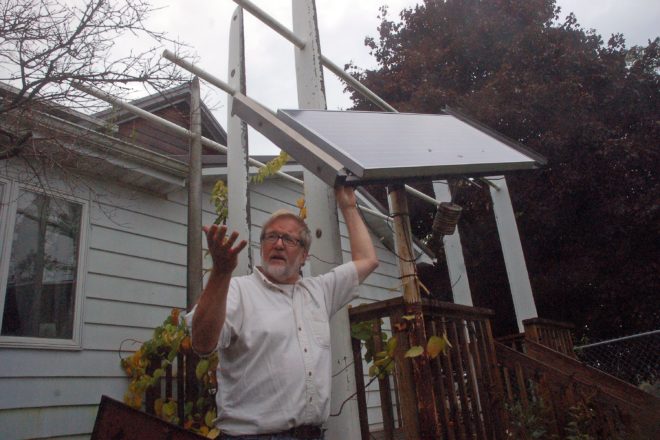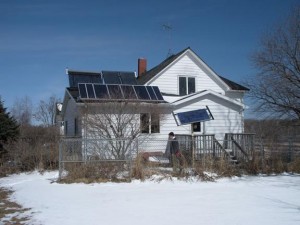Declaring Independence
- Share
- Tweet
- Pin
- Share

Last year, Wisconsinites spent $21.2 billion on energy. The overwhelming majority of those dollars left the state to pay for coal, oil, and natural gas. Door County alone spent roughly $60 million on electricity.
Energy, in short, is a mass exodus of dollars from the Door County economy. But does it have to be?
Well, if constrained by conventional energy thought, then yes. Wisconsin has no coal, no oil, and no natural gas. But the face of energy is changing, and faster than anyone envisioned just a few years ago.
“In Texas they’re erecting wind farms on top of old oil fields,” says Janet Larsen, Director of Research at the Earth Policy Institute in Washington D.C. “It’s really amazing how fast we’re moving toward a renewable energy economy. Last year, for instance, we brought 8,000 megawatts (MW) of wind online and just 1,000 MW of coal.“
In 2005 Wisconsin set a goal of ramping up the percent of the state’s energy garnered from renewable sources to 10 percent by 2015. Spurred in part by the spike in energy prices, experts now think that target can be reached two years early.
Yet we still feel far removed from our energy production, and in a strictly geographic sense, we are. Almost 60 percent of our electricity comes from coal, most of which is imported from Wyoming. But by ignoring where we get our energy from, we’re also separating ourselves from our paychecks and the ethical responsibility for burning fossil fuels.

The latest commercial wind turbines rise to heights nearing 400 feet and provide lease income to farmers.
So in our third Sustainability Issue, we decided to pose a question – can Door County produce its own renewable energy, and if so, where could it come from?
The answer was not easy to come by. The rules of the game are changing rapidly, with new technologies, subsidies, incentives, and regulations hitting paper daily. But we were able to come to some ballpark conclusions by talking to local renewable energy proponents, energy experts, and state officials, supplemented by lots of digging through layers of statistics and research reports.
The baseline: Door County consumes over 564 million kilowatt-hours (kwh) of energy each year, at a cost of approximately $60 million. Providing that much energy will require a multi-pronged approach.
Cutting Use
Before looking at energy production, however, the discussion begins with conservation.
“Energy-efficiency is where you get your biggest bang for the buck,” says Ryan Schryver, a grassroots energy organizer for Clean Wisconsin, an environmental lobby based in Madison.
Put simply, it’s much cheaper to not use a kilowatt-hour of energy in the first place than it is to find a renewable way to produce one.
Most estimates say energy use nationwide could be cut 25 percent just by eliminating waste, and some estimates are much higher. In Door County there’s huge potential to be realized by improving energy-efficiency in buildings and homes.
That’s because Door County, as a tourist community, is home to thousands of condominiums, vacation homes, cottages, and lodging units that sit uninhabited for two thirds of the year but still need to be heated and lit.
No specific numbers are available, but many of the peninsula’s homes were built as summer cottages long before advances in insulation, windows, and heating were widely available. Thousands of cottages, condominiums, and lodging units are heated with electric baseboard heat, the most expensive and least efficient method available.
These homes and units sit empty in the coldest months, yet many of them do not get winterized and must remain heated to prevent pipes from freezing. This is true for many businesses open only on weekends as well. Drive through Fish Creek on a Tuesday night and you’ll find less than a handful of businesses open, but nearly every one has exterior or display lights on. This means a large amount of energy is used to heat and light empty buildings.
Brian Driscoll is the Community Relations Director for the Wisconsin Office of Energy Independence. He’s been touring the state to meet with local governments, schools, and utilities to gather ideas to reduce energy use by government entities.
“We have a goal to reduce our energy use by public buildings by 10 percent between 2005 and 2010, even while adding buildings and services,” Driscoll said.
Driscoll said the state’s on track to meet the goal, mostly through increased efficiencies in systems. “It’s part training, and part technology.”
This means efficient, computerized heating and cooling systems, but also making sure building managers and employees know how to get the most out of them.
Driscoll is encouraging local governments to form their own energy independence teams. In his visits state-wide, he’s found a number of innovative approaches driven by the need to cut costs. Some towns and villages are using neighborhood electric vehicles for routine maintenance, keeping large trucks parked in the garage. Others are replacing lights in public buildings, or even investigating using LEDs for streetlights. In Ashland, they’re replacing coal boilers with woody mass boilers.
But many efficiency measures are still too expensive for small towns and school districts. Driscoll hopes to get entities communicating, and eventually combining purchasing power within counties and across the state to make the up-front investment costs of new technologies affordable for even the smallest towns.
Catching Wind
If Door County can cut its usage, one resource holds the most potential for local energy production, but it is also the most controversial.
“Wind is the largest and most economical of the potential renewable resources,” says Schryver.
John Hippensteel has been promoting wind energy in the county for several years, hosting educational listening sessions around the peninsula. The founder of Community Wind Energy of Door County says the Town of Clay Banks has some of the best wind in the state, and other parts of the county have good sites as well.
Hippensteel said a realistic goal for wind energy would be to build about 40 turbines in small clusters around the peninsula, enough to generate about 25 percent of the county’s electricity requirements. Door County has no commercial turbines today.
Though wind energy is met with enthusiasm in theory, plans stall when it comes time to put it into practice.
Small cluster wind farms are currently the most difficult to build in Wisconsin.
“Most local ordinances effectively ban wind farms,” Schryver says.
Wind farms of 100 MW or larger (about 50 large turbines) are regulated by the Wisconsin Public Service Commission, but those smaller than that are left to the purview of local governments. Counties and municipalities across the state have set vastly different standards for wind power development.
Because of noise and flicker concerns, communities have enforced setbacks of up to a mile from the nearest home for turbines. If the setbacks don’t eliminate wind, Hippensteel says the red tape will.
“The present county wind ordinance is a huge hurdle,” Hippensteel says. “Although the setbacks are fairly reasonable, it requires expensive studies before you can build. A massive energy company with capital could do it with no complaints, but it makes the small-scale things we would want to do unfeasible.”
In Clay Banks, the town enacted its own ordinance last year.
“When you apply the setbacks and restrictions, you find that the only place you could legally erect a turbine is a 3-acre site in a swamp,” Hippensteel says.
The setbacks are imposed for varying reasons, aesthetics chief among them. Though the turbines are shorter than many cell and communication towers, they’re considered a blot on the landscape to many. A two MW wind turbine climbs to a height of about 380 feet from base to the tip of the blade.
Just down the road in Kewaunee County, which doesn’t have a county wind ordinance, 31 turbines dot the horizon, capturing enough wind to power 5,000 – 6,000 homes. The turbines are split between Madison Gas and Electric and Wisconsin Public Service, and were built in 1999.
Kewaunee County Administrator Ed Dorner says the county gets about $100,000 annually from the wind farms, with the towns of Lincoln and Red River generating revenue from the farms as well.
Hippensteel originally pushed to create a locally-based wind energy cooperative, keeping the profits from the wind farm in the community. If the county were able to generate 25 percent of its current energy usage from local wind, it would keep roughly $15 million in energy expenditures from leaving the peninsula.
Legislation began circulating in early April that would pave the way for new, state-wide guidelines for wind development. Schryver says the legislation would not determine setbacks or eliminate local decision-making.
“It would form a committee of stakeholders to set standards,” he says. “Every other power type is regulated by the state, and this would bring wind closer to that playing field.”
In pursuit of our goal, we’ll set ordinances and NIMBY concerns aside, and propose that Door County build 40 wind turbines to produce 25 percent of its energy. Combine this with a mandate to reduce consumption by 25 percent, and we’re already halfway home. Easier than we thought? Not really. The big bites are out of the way now.
Biomass
Peter Taglia served on Governor Jim Doyle’s Task Force on Global Warming and is well versed in another emerging energy source that could help us in our quest. Wisconsin is the nation’s leading producer of biomass energy. That sounds impressive, but it still represents just a fraction of a percent of all energy use in the state. But Driscoll and Taglia are both enthusiastic about its future prospects.
“In 10 to 15 years, it could provide 5 to 10 percent of our energy needs,” Taglia says. “The state has 22 biomass digesters producing 2 to 3 MW of energy today. With a large investment this could emerge as a significant source.”
Biomass is plant or animal matter, and biomass fuels are created from agricultural wastes, alcohol fuels, animal wastes and municipal solid waste.
Biomass turns animal and other organic waste into energy, and works best on large-scale farms. Taglia said only one dairy farm in Door County would fit that definition, but pointed to new opportunities to create community digesters in which several smaller farms and operators would “share” one, as has been done in Dane County.
“It’s hard to do on a community scale, but not impossible,” he says. “It would cost $2 to 5 million to build a small-scale digester. But you’d be able to sell the energy back to the utilities at the renewable energy buy-back rate.”
Energy we never see
So it seems biomass is a good option for the state, but not so great for Door County. Let’s put that at two percent, getting us to 52 and over the halfway point. Now that we’ve started getting our energy closer to home, we’ll achieve savings in another often overlooked segment of the industry.
Line loss, energy used to transport electricity from power plant to the home over power lines, wastes 5 to 8 percent of electricity.
“The more you get energy at different parts of the grid the better you’ll be,” Taglia says. “It eliminates the large distances it has to travel.”
Taglia said producing locally wouldn’t eliminate all line loss, so let’s be conservative and put it at another three percent. We’re up to 54 percent of our total current energy use.
The Big Lightbulb
In the southwest, engineers are making strides in harnessing the power of the sun. While Door County isn’t blessed with the year ‘round rays of Arizona, potential remains nonetheless. Hippensteel, who designs solar heat and electric systems for residential use, said perhaps half of Door County households would be good sites for solar power. That’s roughly 6,000 homes. A 3 kW solar electric system on the roofs of each of those homes would provide an additional 18,000 kwh of electricity. If condo developments, municipal buildings, schools, and hotels were added to the mix, the number would rise dramatically. Let’s shoot for 28,200 kW, or five percent of our energy from solar.
We’re not at 100 percent, but we’ve found a way to eliminate about 60 percent of our present fossil fuel energy consumption. And we’ve left several stones unturned. Could we add a few wind turbines, or supplement them with small, residential turbines? What if offshore turbines on Lake Michigan are included in the mix? Increasing the use of fireplaces and pellet stoves for individual heating needs? Or investing in geothermal heating powered by solar heat pumps?
We could grow this percentage greatly, but at 60 percent, we’re saving 360,000 tons of carbon dioxide emissions, and keeping $36 million in the county that would otherwise leave our economy, and that’s at today’s prices.
Forgetting Something?
Conspicuously absent from our project has been the cost of implementing these new energy resources. This isn’t to ignore them. The numbers would be staggering, hundreds of millions of dollars up front. But the emphasis must first be on the dream, and what could be done. We spend the rest of the year talking about why we can’t.
But Hippensteel says thinking about renewable energy requires an important shift in the cost-benefit analysis that is anathema to most of us.
“With renewable energy you’re paying for all your energy up front,” Hippensteel said. “It’s like buying a car and including the price of gas for the life of the car in the purchase price.”
We can ignore dollars, of course, and do this because we want to (see the sidebar for a great example of a community that did), but it’s more likely we’d only do this out of necessity. Right now, it isn’t, but Larsen says that time is coming, and fast.
“We need to completely restructure our energy system,” Larsen says. “Cities will have to be redesigned. The looming peak oil problem makes it much harder and more expensive to travel and build.”
Last summer gas prices surpassed $4 per gallon in the U.S., and prices will go there again soon. That’s because world oil production has leveled off, and all the oil that’s cheap to get out of the ground has been extracted.
Major corporations have started creating contingency budgets in anticipation of “green taxes,” which would be implemented to show the true cost to society of fossil fuels. This would incorporate health care costs, cleanup, pollution, climate change, and other external costs of burning fossil fuels.
“We have an economy that’s faulty,” Larsen says. “It’s not giving us the true cost of burning fossil fuels. It’s not cheap to burn a gallon of gas, but we have a dishonest market that tells us it is.”
For decades the federal government subsidized fossil fuel production and protected resources with the military – all at tremendous cost. Only in the last couple years have meaningful, wide-ranging incentives been made available for renewable energy. Imagine how fast the dynamic would change if the playing field were level.
“It will soon no longer be free to send carbon dioxide into the atmosphere,” Larsen says.
Hippensteel says it’s vital that we not wait until a crisis to point our economy in a new direction.
“If we use up all our fossil fuels but don’t perfect renewable technologies first, then what are we going to do?” he asks.



